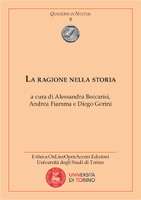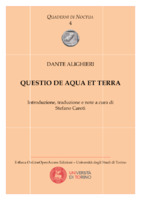Quaderni di Noctua
8 items in collection
I Quaderni di Noctua sono una collana di studi ed edizioni di fonti primarie a revisione paritaria, che mira a rendere disponibili in formato Diamond Open Access contributi che intendono rappresentare lo stato dell’arte sui problemi della storia della filosofia e della scienza dai suoi inizi all’età moderna. Sono egualmente pubblicati contributi in ambiti affini, quali la storia delle idee, la storia intellettuale e la storia culturale. La collana è legata alla rivista Noctua.
Quaderni di Noctua is a peer-reviewed book series which aims to make available, in a Diamond Open Access format, outstanding contributions – monographs, collective volumes, and editions of primary sources – on the problems of the history of philosophy and science from its beginnings to the modern age. It accepts contributions in the kindred fields of the history of ideas, intellectual history, and cultural history as well. The series is related to the journal Noctua.
The volume aims to investigate one of the most layered and pivotal concepts in the philosophical tradition: reason, understood not only as an intellectual faculty but also as a historical force and organizing principle. The book stems from a shared intellectual project initiated at the conference held in Foggia in March 2023, later enriched by contributions developed within PRIN research programs, with the goal of expanding and deepening the inquiry into the theme. Adopting an interdisciplinary and intercultural lens, the volume gathers essays that explore the concept of reason across different philosophical contexts: from classical Greek thought to Christian and Islamic medieval philosophy, from Cartesian and Kantian modernity to contemporary critiques, including lesser-studied fields such as alchemical practices. The collection highlights both the faith in rationality as a driver of human progress and its historical contradictions, epistemological ambiguities, and ethical-political limitations. A central focus lies on the tension between reason and history: on one hand, reason as a guiding force in human development; on the other, history as a testing ground for its validity, as well as a domain of crisis and transformation. This dialectic permeates the volume, offering a multifaceted and critical understanding of a concept that remains central to the human condition.
During the Middle Ages, physicians, philosophers, and theologians developed a complex and rich discourse on the concept of sickness. Illness (infirmitas) was perceived as the natural state of existential imperfection for homo viator, fallen due to sin and impaired in his bodily integrity. Leprosy, smallpox, plague and the other collective diseases that constantly plagued medieval societies prompted reflections on etiology and modes of transmission of epidemics. Building on Galenic teachings, medieval medicine – both Arabic and Latin – delved into the study of fevers. Key concepts in medical pathology, such as the humors, humidum radicale, and spiritus, were assimilated and reinterpreted within philosophical and theological frameworks. The ten contribution collected in this volume explore this rich array of concepts and themes by closely examining the theories and works of prominent and lesser-known figures in medicine, theology, and philosophy active across Latin Christendom, the Islamic context, and the Jewish world: from Augustine to ʿAlī ibn al-ʿAbbas al-Maǧūsī, from Avicenna to Constantine the African, from Maimonides to Albert the Great, from Arnau de Vilanova to Gentile da Foligno, from Henry of Herford to Michele Savonarola.
The volume includes an extensive introductory essay and an Italian translation of the treatise On Man, His Mortality or Immortality by Aleksandr Nikolaevič Radiščev, written in Siberia between 1792 and 1796, published several years after the author’s death. The treatise begins with an exploration of the paths and achievements of the different sciences that offer knowledge of the various aspects of the human world, but do not penetrate its essence. At the foundation of the manifold and the changeable, there remains, unknown and indefinable, the unitary substance. Behind the Leibniz of the epigraph, behind Herder and Mendelssohn, there appears, unspoken, the dangerous, and perhaps most beloved, Spinoza. Radiščev is an emblematic figure of 18th-century Russia, considered the theorist of equality and by some critics, wrongly, a precursor of the Russian Revolution. Radiščev’s thought in this regard is clear and matures through the readings of Beccaria, Filangieri and Dragonetti: equality of nature (natural law) is utopian if it does not become equality before the law.
The 26 essays collected in this volume explore some crucial aspects of the philosophical and scientific traditions of the Middle Ages and the Renaissance. Using a historical-philological approach, the volume brings to light unpublished documents and offers new reconstructions of the intellectual paths of authors such as Meister Eckhart, Nicole Oresme, John Buridan, Siger of Brabant, William of Ockham, Peter Pomponazzi, and Giovanni Pico della Mirandola.
This volume offers a new edition of the original text and an Italian translation of Dante Alighieri’s Questio de aqua et terra, discussed in Verona in 1320. The introductory apparatus and the textual commentary reconstruct the historical context of the quaestio (in the light of the debates on the nature of the elements and Aristotelian cosmology), its discussions in the historiography of science and philosophy, and the fortune of the text in its editions from the sixteenth century onwards.
The 14 essays collected in this volume explore the various aspects of Augustine’s philosophy and its medieval reception: by considering his education and the development of his thought as conveyed by a series of philosophical images and styles, the volume reconstructs the recurring motifs of his intellectual journey (the anti-Manichean polemic, his political vision, the role of reason, and the theory of war) and their fortune in authors such as Thomas Aquinas, Nicole Oresme, Gregory of Rimini, and Robert Grosseteste.
The 14 essays in this volume explore the relationship between philosophy and religion from antiquity to the contemporary age, as well as the development of a philosophy of religion in modern times. It does so by focusing on the topics of atheism, the nature of Christ, and the Cartesian origins of rational theology, on the one hand, and on the contemporary ramifications of philosophy of religion: in hermeneutics, phenomenology, and historical materialism, on the other.
The volume includes the Italian translation of Giordano Bruno by Lev Platonovič Karsavin, a preface by the translator and an introduction by Julya Mehlich, a scholar of Karsavin. The translated text was published in Berlin in 1923 and long ignored by the extensive bibliographies on Bruno and Karsavin. Bruno’s value, according to Karsavin, lies in the sentiment and in the clear awareness of his own unity of spirit with the divine Universe and with God himself. “The soul of Nolan’s philosophy” is “heroic fury,” the theoretical and practical foundation of unity of life and thought. But in this Karsavin also grasps Bruno’s limitation: that is, the failure to be able to be faithful to the intuition that the Absolute is never identified with the totality, even if infinite, of the relative. The infinity of the Divine is, in fact, essentially different from the infinity of the empirical. In this confusion, Bruno would be the emblem of the entire Renaissance era. In her Introduction, Mehlich highlights the use of a double method in Karsavin’s treatment: the formal one of individualization, by Heinrich Rickert, and the one based on the principle of vseedinstvo (unitotality), dating back to the thinking of Vladimir Sergeevič Solov’ëv, and widely used in 20th Century’s Russian philosophical-religious thinking. A peculiarity of Karsavin’s approach would be, according to the scholar, the union of the two levels with the conception of the historical being as personal, and the development of history as the history of the person, as narration of his destiny.
Collection Tree
- Quaderni di Noctua








